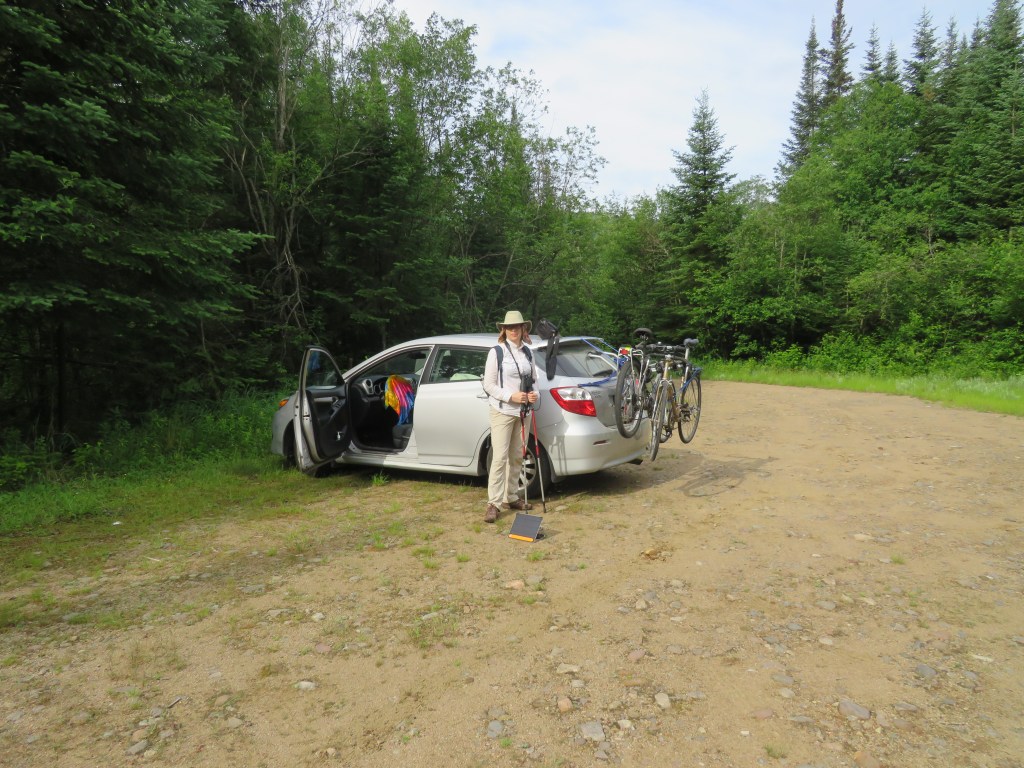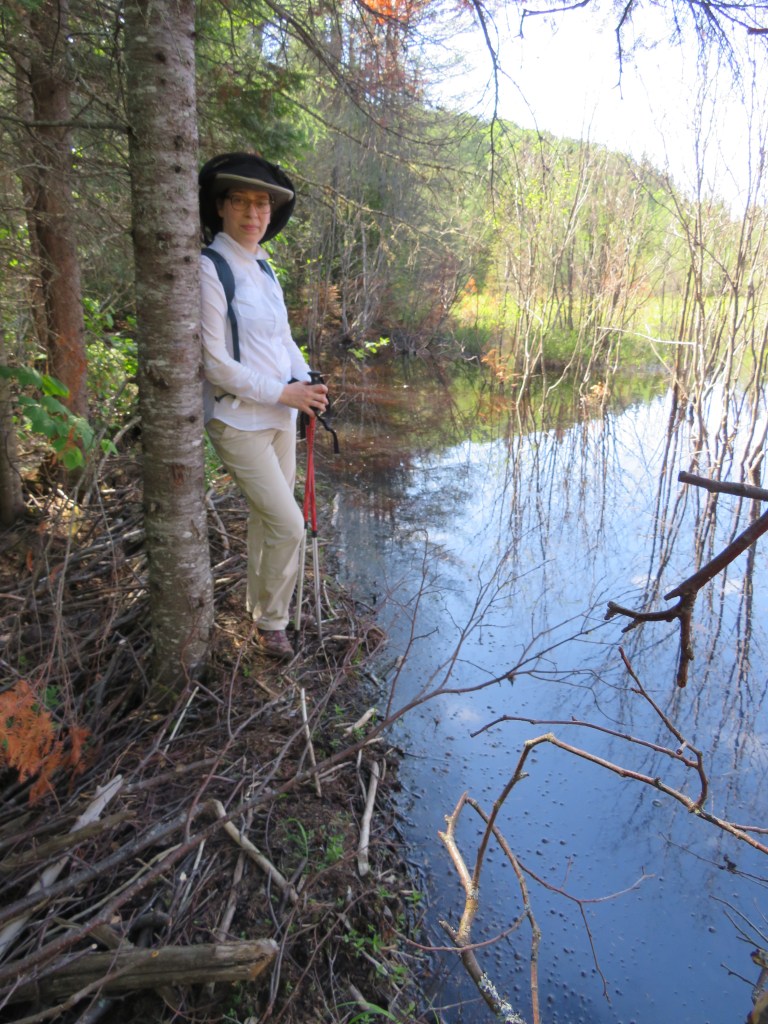A great birding moment in Parc National du Mont Tremblant on July 3, 2020.
After cycling 54 kilometres from Saint Faustin du Caré to the Mont Tremblant Village and back on Thursday, I was ready for a restful Friday morning with reading time in the hammock and a cool swim before heading home. That was until Cris talked me into going birding. “Don’t you want to find the Bicknell’s Thrush on le Carcan?” she implored over dinner on Thursday evening. That was all I needed to hear. Cris had been with me on several occasions when I had failed to find a Bicknell’s Thrush, including one earlier in the week at Mont Johansen in the Park. Friday was our last of five days in Parc national du Mont Tremblant and the last opportunity to try and find this elusive species. My history with the species was one of failure, so what would be different this time? “You’ll get your bird this time” she said confidently. I wasn’t so confident.
Bicknell’s Thrush is a Threatened songbird that lives on the mountaintops of northeastern North America. Most of its range is in Quebec where it occurs in dense stunted spruce forests, mainly above 700 metres away from the Atlantic coast. Bicknell’s Thrush migrates to the Greater Antilles, overwintering on high elevations in Cuba, Hispaniola, and Puerto Rico. Extreme deforestation on the wintering grounds, climate change, and habitat loss on the mountaintops on the breeding grounds is threatening the species’ survival.

Next morning I was up making coffee at 5H30 and we broke camp by 7 am, but didn’t reach the Carcan Trail Head until 8:30. The road to the trailhead was rough. Hoards of hungry mosquitos awaited us in the parking lot, along with a sign stating that the trail had received no maintenance for over a year. The Carcan Trail is a 14 km round trip hike with a vertical climb of 530 metres. At 883 metres above sea level, Le Carcan is the second highest peak in the expansive Parc national du Mont Tremblant and one with historical records of this rare thrush, the only regularly occurring songbird in Eastern Canada that I have not observed. I was cautiously optimistic. Even with no Thrush, the hike would be a good physical challenge and worth it.

The trail was indeed a challenge. The first 1.5 kilometres followed an old logging road. That’s where we encountered the first trees across the trail. Once the trail left the logging road, the first real test came. The path led straight into a small lake, emerging about 30 metres beyond. It was not clear how we could cross this without getting very wet. However, a bit of off trail exploring led to the beaver dam that had caused the flood. We had to cross about 30 metres of dam to get to dryer land on the other side, then work our way through the forest to find the trail. Once back on the trail, we continued through maple and birch lowlands, before starting up the base of the mountain. The trail meandered along, adjacent to a tumbling stream with attractive waterfalls. The bird community was vibrant and the air full of song, dominated by the uniquitous Swainson’s Thrush (close cousin of the Bicknell’s Thrush). There were also Veerys, Hermit Thrushes, White-throated Sparrows, Winter Wrens, and several warbler species including Black-throated Green, Black-throated Blue, Northern Parula, American Redstart, Black and White, Chestnut-sided, Blackburnian, Ovenbird, and Yellow-rumped. Yellow-bellied Sapsuckers, Red-breasted Nuthatches, and Blue-headed Vireo were also common.
At times, it was challenging to locate the trail, which was often blocked by fallen trees. As we climbed, the forest changed from mixed hardwoods and conifers to spruce and fir conifer forest. I encountered the first ‘boreal’ species of bird just after kilometre 4 – a stunning Black-backed Woodpecker. Shortly after, a family of Boreal Chickadees announced their presence with their wheezy “sick a djee” calls, along with a Pine Siskin.
Around the 5 km mark, we spotted a Spruce Grouse displaying on the side of the trail. Just beyond was its brood of at least four Spruce Grouse chicks. These were all somewhat unexpected boreal species that I was delighted to observe! With a kilometre to go, the trail was nearing the summit and the forest was noticeably shorter and denser, and dominated by spruce. Though I had never observed a Bicknell’s Thrush in its breeding habitat, I knew that we were in the right place, and with a bit of luck, we might be rewarded.
Finally we reached the top, where there was an exposed rock area to sit for lunch and take in the view. Swainson’s Thrushes were still present, without doubt the most numerous species throughout the trail. There were also a few other species singing, including Magnolia, Nashville, and Yellow-rumped Warblers. It was about noon by this time and the bird song level had subsided.
While at the summit, we were joined by two other hikers with whom we shared our experiences and thoughts about the trail. During this conversation I heard a call note that caused me to pause and to excuse myself from the conversation. I walked a few metres to get a better view into the dense forest of where the sound was coming from. I was extremely excited as I was certain the call was from a Bicknell’s Thrush. The call note was emphatic and high-pitched with a definite descending tone, completely different from the call note of the Swainson’s Thrush, which ascends. The call came from the dense stunted spruce forest in front of us. The bird called frequently, and after a minute or two, to my delight, it burst into song, a distinctive descending fluted song. I pulled out my phone to listen to the Bicknell’s Thrush song on my Sibley app. Sure enough the singing bird was confirmed. I then pished and watched, and the bird responded by flying past, through the Spruce trees in front of me. I was able to see its rich reddish-brown back as it flew by twice. It continued singing as I soaked up this wonderful moment. Eventually I settled back down with the others, excusing myself for leaving the conversation. The other two hikers were fascinated by both me and the bird. I looked up and noticed two Turkey Vultures soaring over the summit with a raven-sized raptor aggressively driving them away. The powerful bird was my favourite bird of prey, a Northern Goshawk! Goshawk is the epitome of power. Years can pass for me without seeing one. When I do, I get goosebumps. I had goshawk goosebumps on my Bicknell’s thrush goosebumps!
I finally sat down to finish my lunch, thinking how the hike was so worth the effort and how grateful I was of Cris for supporting my birding passion and for encouraging the hike. At that moment the beautiful notes of a Fox Sparrow’s song registered in my head. It may have been singing for a while without me noticing because of the Bicknell’s and the Goshawk. I had not even realized that Fox Sparrow bred in Mont Tremblant Park, as it is really a northern boreal forest species, so this was a wonderful surprise. We were able to get excellent views of this top-notch singer, named because of its beautiful rusty plumage.
Birding trips and hiking trips can be disappointing if we set our expectations too high. For the Carcan hike, I was hopeful, but without high expectations. On every front, both Cris and I were delighted and exhilated by the birds, the hike, and the nature. The Carcan trail is one of the best birding/hiking trips that I’ve done in Canada.
Awesome Ted! Enjoyed this immensely. Mary
Sent from my iPhone
>
Thanks Mary, It took a long time to share . . . .